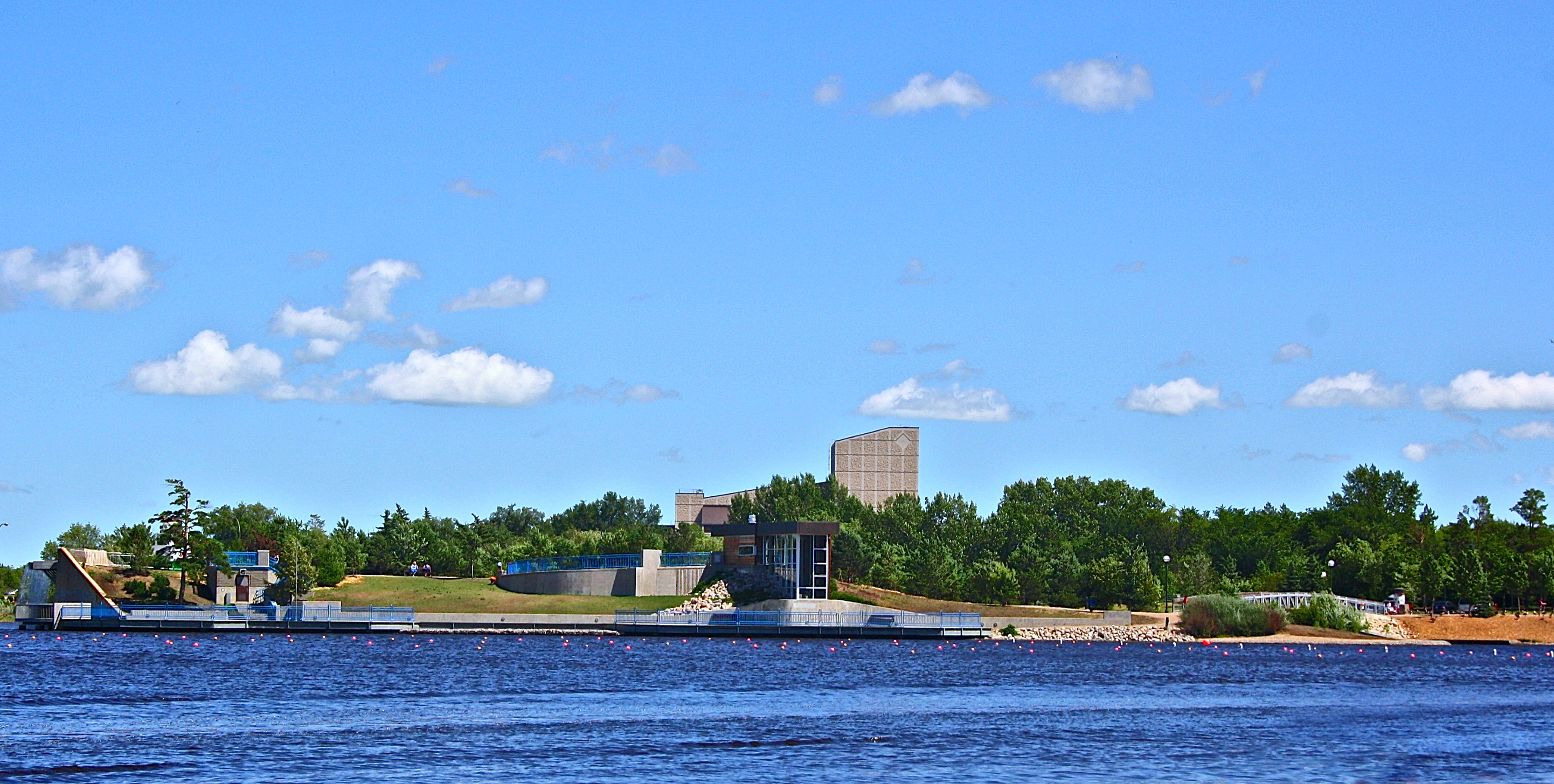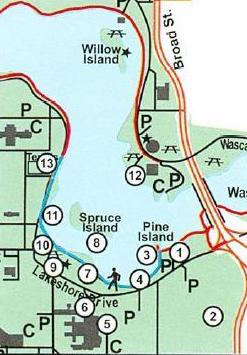
1.5 kilometres - 25 minutes

This walk begins in the parking lot beside Pine Island. Across the lake to the north is the Wascana Marina, one of Wascana Centre's many facilities constructed to encourage recreation.
On the southwest corner of Old Broad Street and Lakeshore Drive is the Wascana Centre Tree & Shrub Nursery. The majority of the trees and some of the shrubs are grown and transplanted to projects throughout Wascana Centre. The nursery consists of 13 hectares of land which yield many species of plants that include:
a) Trees - American Elm, Maple species, Pear species, Plum species, Mayday, Ornamental Crab species, Russian Olive, Hawthorn, Japanese Tree Lilac, Colorado Spruce, Poplar species, Shubert Chokecherry, Amur Chokecherry, Pine species, Siberian Larch, Linden species, Ash species, Paper Birch, Mountain Ash species, Pincherry, Bur Oak, Ohio Buckeye, Butternut, Willow species, Black Walnut (Wascana seed source).
b) Large Shrubs - Lilac species, Cotoneaster, Honeysuckle, Red Dogwood, Caragana, Buffaloberry, Common Sea Buckthorn, Highbush Cranberry and Wayfaring Tree.
The trees and shrubs are all grown on a rotational basis that is part of the nursery management plan and is predetermined by the requirements of Wascana Centre’s tree inventory.Just east of the current tree nursery is the site of Wascana Centre's old tree nursery. Over time, some of the trees in the nursery grew too large to be moved and a new working nursery was moved east to the other side of Old Broad Street. In 2017, construction crews started work on transforming the area into an Arboretum. The Arboretum includes a natural habitat marsh area to mitigate drainage issues, provide a place for wildlife, as well as provide new pathways for the Centre. As part of this project, retention pond was built to contain storm water and a number of drainage ditches were designed to help prevent flooding in the area. Trails were put in so that people can walk through the area and enjoy the landscape as a quiet, natural area in the midst of a highly urban envioronment. Among the species of trees that will be found in Arboretum Park are the American Linden, Black Walnut, Bur Oak, Ohio Buckeye and Colarado Spruce. Many of the majecstic trees in the area are over 50 years old.
- As you walk across to Pine Island you must reflect on the origin of this site. The Old Broad Street bridge was built here in 1908 and the height of the bridge allowed sailboats to pass underneath. In 1960 this bridge was replaced with the new bridge you can see to the east. In 2004 this area was transformed into an island with a beautiful waterfall cascading over the old bridge abutment, an overlook above the waterfall and the Finishing Line Facility/a judging area for competitions which was completed in 2014. The deepest area of Wascana Lake is directly west of Pine Island. It was excavated in 2004 to a depth of 9m. The average depth of Wascana Lake is 5m.
- Moving off Pine Island the right hand path follows a curve down to Surveyor's Monument. This monument is dedicated to the surveyors of Canada and Saskatchewan whose skill and industry contribute greatly to the exploration, mapping and development of our nation. The monument was designed by Jack Walker in 1967, and contains surveying artefacts representing Canada’s first 100 years of exploration and development as a nation. These artifacts will be historically significant when the cairn is opened in 2067.
- The red brick building to the south is the Wascana Rehabilitation Centre. It is a specialty hospital which emphasizes rehabilitation of the physically disabled and treatment of patients suffering from chronic conditions. A playground was opened in 2010 after three young women (Wascana Centre Seasonal Employees), Carmen Danyluk, Laura Stark and Megan Cross, saw a need for modern play equipment at Wascana Rehab. They took ownership of the idea and formed a not-for-profit community group to raise money and move the plan forward. Stark and Danyluk were seasonal employees of the Wascana Centre and Cross had been a volunteer with the children’s program at Wascana Rehab. The three twentysomething women applied for grants and help co-ordinate a partnership between Regina Qu’Appelle Health Region, Wascana Rehab, Wascana Centre and the Ministry of Government services. Wascana Rehab’s playground gets a lot of use; each year, more than 1,200 children with physical and/or cognitive disabilities use the children’s program at the rehab centre. The new playground offers a modern play area that combines therapeutic benefits with fun.
- The path leads past the Boy Scout Monument on the right. It was dedicated in 1965 to sixty years of Boy Scouting in Saskatchewan. The smaller cairns surrounding the large one are each engraved with a Boy Scout motto. The entire monument represents a sundial.
- Spruce Island can be seen across the lake from the pathway along the shoreline. This island, along with Willow Island, was built in the 1930's using the excavated dirt from the deepening of the lake. Both islands were expanded during the 2004 dig. Today Spruce Island is left in a natural state and serves as a bird sanctuary.
- You are now in Lakeshore Park. It is one of the oldest and most popular barbeque areas in Wascana Centre. This is a wonderful spot to bring the family for an outing.
- A central point in this picnic area is the totem pole. It was given to the Province of Saskatchewan by the Government of British Columbia to commemorate their centennial year in 1971. It was carved by a member of the Nimpkish Indian Band of Vancouver, British Columbia. In 2016, Lloyd Wadhams (son of the origianl carver) spent the year restoring the totem pole to its original condition.
- To the left of the path you will find the Sisters Legacy Statue. The monument, sculpted by Prince Albert artist, Jack Jensen, features two Catholic Sisters cast in bronze, one representing a teacher, the other a nurse. The installation commemorates the courage and commitment of religious women across Saskatchewan who established needed health services and education to their local communities, laying the foundation for modern day education and healthcare delivery in Saskatchewan.
- Spruce Island Overlook houses the pump that takes water from the lake to irrigate the grounds along the south shore of the lake. The discharge pipe that is decorated with animals was designed to portray some of the characters in the story “A Better Place”. The children of Douglas Park school were asked to participate in the naming of this site and created the story. You can read the story “A Better Place” on the plaque at the front of the overlook. From this location the west side of Spruce Island can be seen.
- To the right of the path you will see the Holodomor Statue which was erected in th espring of 2015. The monument project was spearheaded by the Ukrainian Canadian Congress Volunteer Group. The UCC, Regina Branch purchased an exact copy of the life size bronze statue by sculpture Petro Drozdowsky. The original statue is located near the entrance to the National Holodomor Museum in Kyiv, Ukraine.
This monument is to memorialize the Holodomor endured by the Ukrainian people in 1932-33. The Holodomor was a man-made famine in the Ukrainian SSR and adjacent Cossack territories between 1932 and 1933. During the famine millions of Ukrainians and Cossacks died of starvation in a peacetime catastrophe unprecedented in the history of Ukraine.
- In 1915 the Lakeshore Tennis Club was established for use by civil service employees and had four grass courts. By 1924 the increase in membership meant the addition of a fifth court and the surface of all courts was converted to crushed shale which was replaced by asphalt in 1959. The club underwent another change in 2004 with the addition of 3 more courts which were built to international specifications and used for the 2005 Canada Summer Games.
The aesthetic atmosphere of Wascana provides a hide-a-way from busy city life. Every day hundreds of Reginans together with visitors from all over the world use and enjoy Wascana Centre.



with our newsletter